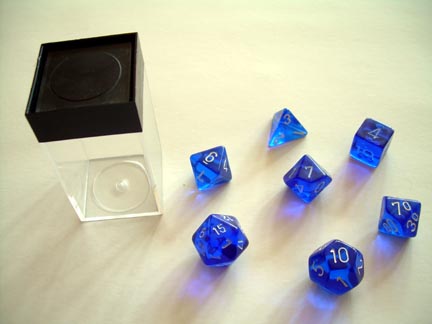


The Case for Dragon Dice
Dragon dice are one of the most under-utilized resources for math games. They're cheap, they're cool, and they're versatile. If that appeals to you, read on!
Dragon dice are so called because of their use in the original Dungeons and Dragons role-playing game. Every gaming store carries them, and, if you don't have one of those in your area, just check online. You can buy a set on ebay for less than $5. They come in every style from plain to marbled to translucent (my personal favorite!).
Dee Who?
A set of dragon dice includes one of each of the following: d4, d6, d8, d10, d12, d20, and d100. The "d" stands for the highest value that can be rolled; a d4, which is shaped like a pyramid, has the values 1-4. The exceptions are the d10, which has the numbers 0-9, and the d100, which goes from 0 to 90 in increments of 10. (The zero can also be used as a ten, if desired.)
Because they can generate numbers from 0 to 100, dragon dice are excellent for both simple and complex games. An easy adding task using dragon dice might be, "Roll d4 twice, adding the two numbers." A more advanced task would be, "Roll d100, d20, d12, and d8, giving the sum."
Some Ideas
Race games often use dice to determine how many spaces a figure can advance. For instance, you might have a rule that after answering a problem correctly, the player can advance d6 spaces; using d4 would decrease the element of luck, while d8 would increase it. Many race games also have "move ahead/back x spaces," for which dragon dice can also be used. One game I designed, Race to Altair, has "Warp" (move ahead) and "Black Hole" (move back) spaces; at the beginning of the game, these use d4, then progressing to d6, d8, and finally d10. This heightens the element of luck at the end of the game.
Another common use for dice is addition. In "Tug of War," players roll a regular six-sided die to move a playing piece to their side of the board. "Catman," designed by my son, is superhero-themed column-addition game.
The d10 die works very well for reviewing basic addition and multiplication facts, while the d20 suggests itself for subtraction facts. Typical tasks include: "Roll d10 twice and multiply the two numbers" or "Roll d20 and d10, subtracting the smaller number from the larger." "King Richards Ransom" makes extensive use of dragon dice for addition, subtraction, and multiplication.